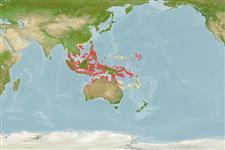Common names from other countries
>
Eupercaria/misc (Various families in series Eupercaria) >
Labridae (Wrasses) > Corinae
Etymology: Halichoeres: Greek, als, alis = salt + Greek, choiros = pig (Ref. 45335).
More on author: Bloch.
Environment: milieu / climate zone / depth range / distribution range
Οικολογία
Θαλασσινό(ά) Υφαλόφιλο(α); εύρος βάθους 0 - 10 m (Ref. 9710). Tropical; 19°N - 12°S
Western Central Pacific: Philippines to the Great Barrier Reef (Ref. 2334). Restricted to the Indo-Malayan region in the broad sense.
Μέγεθος / Βάρος / Age
Maturity: Lm ? range ? - ? cm
Max length : 19.0 cm SL αρσενικό/απροσδιόριστο; (Ref. 9823)
Short description
Κλείδες προσδιορισμού | Μορφολογία | Μορφομετρία
Ραχιαίες άκανθες (συνολικά) : 9; Μαλακές ραχιαίες ακτίνες (συνολικά) : 10 - 11; Εδρικές άκανθες: 3; Μαλακές εδρικές ακτίνες: 10 - 11; Σπόνδυλοι: 25. Usually bright green in algae habitat, but pale or with longitudinal dark bands on plain rubble (Ref. 48636). Head of male with intricate reticulate pattern of bands that varies from one individual to another; small blackish spot on anus. Juveniles and females with dark dots dorsally and posteriorly; these are lost in males. Anterior lateral line scales with 1-3 pores; 8-13 suborbital pores. Anterior dorsal and anal soft rays longer than posterior rays; male pelvic fins not reaching the anus.
Inhabits shallow protected coral reefs and nearby silty sand and rubble bottoms (Ref. 2334). Feeds mainly on hard-shelled prey, including mollusks, crustaceans and sea urchins (Ref. 9823).
Life cycle and mating behavior
Maturities | Αναπαραγωγή | Spawnings | Egg(s) | Fecundities | Προνύμφες
Distinct pairing during breeding (Ref. 205).
Randall, J.E., G.R. Allen and R.C. Steene, 1990. Fishes of the Great Barrier Reef and Coral Sea. University of Hawaii Press, Honolulu, Hawaii. 506 p. (Ref. 2334)
IUCN Red List Status (Ref. 130435)
CITES (Ref. 128078)
Not Evaluated
Threat to humans
Harmless
Human uses
αλιεία: περιορισμένης εμπορικότητας; Ενυδρείο: Εμπορικό(ά)
Εργαλεία
Special reports
Download XML
Διαδικτυακές πηγές
Estimates based on models
Preferred temperature (Ref.
115969): 28 - 29.3, mean 28.8 (based on 1830 cells).
Phylogenetic diversity index (Ref.
82804): PD
50 = 0.5000 [Uniqueness, from 0.5 = low to 2.0 = high].
Bayesian length-weight: a=0.00741 (0.00424 - 0.01297), b=3.03 (2.88 - 3.18), in cm Total Length, based on LWR estimates for this species & Genus-body shape (Ref.
93245).
Τροφικό Επίπεδο (Ref.
69278): 3.4 ±0.40 se; based on food items.
Ελαστικότητα (Ref.
120179): Μεσαίο(α), ελάχιστος χρόνος για διπλασιασμό πληθυσμού 1,4 - 4,4 έτη (Preliminary K or Fecundity.).
Fishing Vulnerability (Ref.
59153): Low vulnerability (13 of 100).
